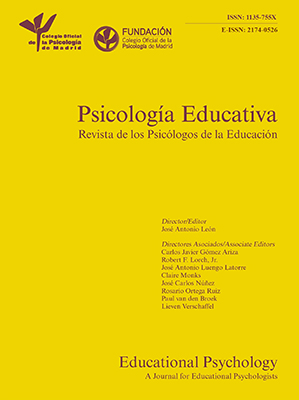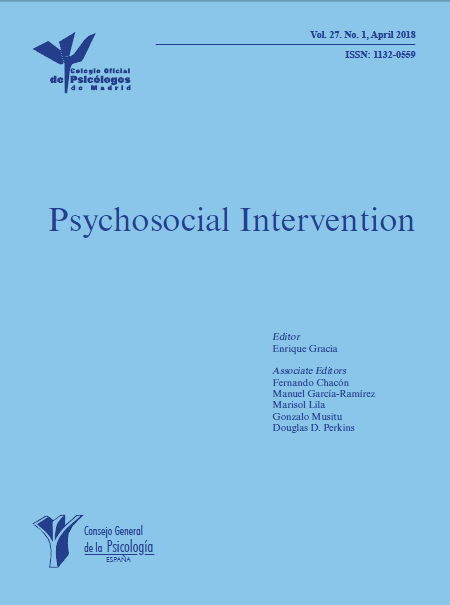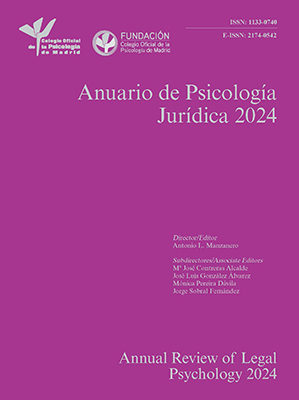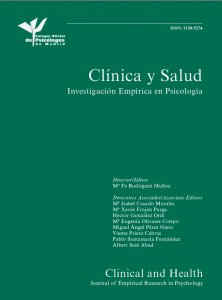
A Meta-analysis of the Relationship between Cognitive Intelligence and the Big Five Assessed by Quasi-Ipsative Forced-choice Personality Inventories: Implications for Predicting Job Performance
[Un meta-análisis de la relación entre la inteligencia cognitiva y los “cinco grandes” evaluados mediante inventarios de personalidad de elección forzosa quasi-ipsativos: implicaciones para la predicción del desempeño laboral]
Alexandra Martínez, Mario Lado, Dámaris Cuadrado, and Jesús F. Salgado
University of Santiago de Compostela, Spain
https://doi.org/10.5093/jwop2025a3
Received 15 January 2025, Accepted 28 March 2025
Abstract
This article presents a meta-analysis of the relationship between cognitive intelligence (CI) and the Big Five assessed by quasi-ipsative forced-choice inventories (QIFC). The results showed small effect sizes between CI and the Big Five, assessed with QIFC inventories, ranging from ρ = -.02 to ρ = .10. It has been found that only openness to experience shares validity with CI, showing slight moderate correlations (ρ = .18). Moreover, the multiple regression analysis carried out indicated that personality increases its incremental validity over CI for predicting job performance. Lastly, the contributions and practical implications of these findings are discussed.
Resumen
Este artículo presenta un meta-análisis de la relación entre la inteligencia cognitiva (IC) y los “cinco grandes”, evaluados mediante inventarios de personalidad de elección forzosa quasi-ipsativos (EFQI). Los resultados mostraron tamaños del efecto pequeños entre la IC y los “cinco grandes”, evaluados mediante inventarios EFQI, que oscilan entre ρ = -.02 y ρ = .10. Se ha observado que solo la apertura a la experiencia comparte validez con la IC, mostrando correlaciones ligeramente moderadas (ρ = .18). Además, el análisis de regresión múltiple indicó que la personalidad añade validez a la IC para predecir el desempeño laboral. Finalmente, se discuten las contribuciones e implicaciones prácticas de estos hallazgos.
Palabras clave
Inventarios de elección forzosa quasi-ipsativos, Los “cinco grandes”, Inteligencia cognitiva, Validez añadida, Desempeño laboralKeywords
Quasi-ipsative forced-choice inventories, Big Five, Cognitive intelligence, Incremental validity, Job performanceCite this article as: Martínez, A., Lado, M., Cuadrado, D., & Salgado, J. F. (2025). A Meta-analysis of the Relationship between Cognitive Intelligence and the Big Five Assessed by Quasi-Ipsative Forced-choice Personality Inventories: Implications for Predicting Job Performance. Journal of Work and Organizational Psychology, 41(1), 19 - 26. https://doi.org/10.5093/jwop2025a3
Correspondence: alexandra.martinez@usc.es (A. Martinez); jesus.salgado@usc.es (J. F. Salgado)., Correspondence: alexandra.martinez@usc.es (A. Martinez); jesus.salgado@usc.es (J. F. Salgado).In recent decades, personality assessment has been a topic of great interest in the field of work and organizational psychology and, particularly, in the personnel selection area, due to its usefulness in decision-making processes related to work and academic issues (e.g., selection, competency development, career planning). Empirical evidence has shown that personality measures based on the Five-Factor Model (FFM) are relevant predictors of several job and academic performance outcomes (e.g., Barrick et al., 2001; Cuadrado et al., 2021; Judge et al., 2013; Poropat, 2009; Salgado, 2003; Salgado, 2017a; Salgado & Táuriz, 2014). In personnel selection research, most of the studies conducted in the last four decades on the FFM have focused on single-stimulus (SS) personality inventories’ effectiveness for predicting job performance. SS personality inventories (e.g., NEO-PI-R, BFI, 16PF-V) are the most frequently used measures of personality. They present to the respondent a single item each time which must be rated typically using a Likert scale. Also, the items are responded to independently. This corpus of research has mainly examined four major issues: (1) the predictive validity of the Big Five, (2) the correlation between the Big Five and cognitive intelligence (CI), (3) the incremental validity of the Big Five as assessed by SS personality inventories over the validity of cognitive intelligence, and (4) the effects of faking on the reliability and validity of SS personality inventories. With regard to predictive validity, the meta-analytic evidence has shown that the Big Five assessed with SS personality inventories showed small validity coefficients for predicting job performance, conscientiousness being the best personality predictor of performance with similar predictive validity across different positions and occupations (Barrick et al., 2001; Judge et al., 2013; Salgado, 2003). For example, Judge et al. (2013) found a correlation of .26 between conscientiousness and overall job performance. Regarding the relationship between CI and the Big Five, several meta-analyses (Judge et al., 2007; Ones, 1993; Stanek & Ones, 2023) have shown that the correlation between CI and emotional stability, extraversion, agreeableness, and conscientiousness is very small, and the correlation is medium for openness. For instance, in the largest meta-analysis conducted so far, Stanek and Ones (2023) found that the correlation with CI was .08, -.02, .26, -.01, and .01 for emotional stability, extraversion, openness, agreeableness, and conscientiousness, respectively. Concerning incremental validity (e.g., Schmidt & Hunter, 1998; Schmidt et al., 2006; Schmidt et al., 2008) argued that the Big Five’s incremental validity over CI for predicting job performance might be very small. Schmidt et al. (2008) used meta-analytically derived correlation matrices to examine the Big Five’s incremental validity over CI for predicting both job performance and training success. As expected, they found that the real contribution of the Big Five beyond CI was very small. With regard to faking, SS personality inventories have been repeatedly criticized because they are severely affected by faking (Morgeson et al., 2007; Murphy & Dzieweczynski, 2005; Salgado, 2016a). The meta-analysis by Salgado (2016a) showed that faking affected reliability and validity, as well as the mean and standard deviation of the distribution of scores. In order to overcome the above-mentioned limitations of SS personality inventories, quasi-ipsative forced-choice (QIFC) personality inventories have been suggested as a robust alternative for measuring the Big Five, as research has shown that they show higher criterion validity and they are robust against the distortion caused by faking. In the next section, we will examine the research literature on these kinds of personality inventories. Quasi-ipsative Forced-choice (QIFC) Personality Inventories Forced-choice (FC) personality inventories are a type of measure characterized by the fact that individuals must choose, rank, or grade two or more alternatives (generally the options are presented grouped in pairs, triads, or tetrads) that have similar degree of social desirability, making the task of selecting the most socially acceptable option more complex. FC personality inventories assume that, due to the difficulty of responding in a desirable way, individuals will tend to choose the alternative that they most identify with themselves, thereby reducing the effect of faking on scores (Christiansen et al., 2005; Converse et al., 2008; Jackson et al., 2000; Salgado & Lado, 2018). Therefore, FC inventories differ from traditional SS measures in that individuals must make a “forced” choice among various items and not just independently rate each alternative, as is the case in SS measures (Salgado, 2017a). As with other personality assessment strategies, different formats of FC inventories can be distinguished based on the design and methodological procedures applied to obtain scores in each case. Depending on their nature, FC personality inventories can produce three different types of scores: normative, ipsative, and quasi-ipsative (or partially ipsative) scores (e.g., Clemans, 1966; Hicks, 1970; Meade, 2004; Salgado & Táuriz, 2014). Normative FC inventories are characterized by presenting only answers-alternatives for the same dimension in each item, that is, each item evaluates just one personality factor, and the same alternatives are never used to represent different factors. In ipsative FC inventories the individual must assess all the alternatives given for each item. Therefore, the score for each dimension depends on an individual’s scores on the other graded dimensions and, consequently, the sum of the scores obtained for each individual is a constant. Finally, quasi-ipsative FC inventories include cases that do not meet all criteria to be purely ipsative but present some characteristics associated with them (Clemans, 1966; Hicks, 1970; Meade, 2004; Salgado & Lado, 2018; Salgado & Táuriz, 2014). A quasi-ipsative score is obtained when some of the following criteria apply: (1) individuals order the alternatives only partially; (2) scales have different numbers of items; (3) not all of the items ranked by respondents are scored; (4) scales are scored differently for different respondent characteristics; (5) items differ in how they are weighted; (6) some ipsative scales are deleted when data are analyzed; and (7) the inventory includes normative sections. Three recent meta-analyses have examined the Big Five’s validity as assessed with quasi-ipsative FC personality inventories for predicting overall job performance, academic performance, and training proficiency. Salgado and his colleagues (Salgado et al., 2015; Salgado & Táuriz, 2014) found that the criterion-related validity increased noticeably when QIFC formats were used. For example, the operational validity of conscientiousness was .39 when a QIFC format was used. Fisher et al. (2019), in a new meta-analysis of 11 studies (n = 613), not included in Salgado et al.’s (2015; see also Salgado & Táuriz, 2014) database, found that the validity of conscientiousness was .38 for predicting overall job performance. In another meta-analysis, Salgado (2017a) examined the moderator effects of job complexity on the Big Five’s validity for predicting overall job performance. This study was designed to test two hypotheses, according to which job complexity would negatively affect the validity of conscientiousness and emotional stability (Hypothesis 1) and they would have positive effects on the validity of openness to experience (Hypothesis 2). The results have supported Hypothesis 1, as the criterion validity of emotional stability and conscientiousness was larger for occupations with lower levels of job complexity than for the occupations with high job complexity. The findings also supported Hypothesis 2 because openness to experience was a better predictor of job performance for high complexity level occupations. This meta-analysis also showed that agreeableness can be a valid and relevant predictor of job performance for medium complexity level occupations when this personality factor is assessed with a QIFC. This set of meta-analyses found that QIFC are better predictors of job performance, occupational training, and academic success than their counterpart measures, i.e., single-stimulus (SS) personality inventories (e.g., NEO-PI-R). For instance, whereas Barrick et al. (2001) and Judge et al. (2013) found corrected validities of .23 and .26 for conscientiousness as a predictor of overall job performance, Salgado and Tauriz (2014), Salgado et al. (2015), Salgado (2017a) and Fisher et al. (2019) found a corrected validity of .39. Concerning the faking resistance of QIFC, recent meta-analytic research has shown that FC personality inventories are robust procedures against faking effects, particularly, in the case of quasi-ipsative format (Cao & Drasgow, 2019; Martínez, 2020; Martínez & Salgado, 2021). In fact, recent research has shown that after controlling for transient error effects, faking has no practical effect on QIFC personality inventories (Martínez et al., 2022). In summary, from the point of view of criterion-related validity and resistance to faking, QIFC personality inventories are an excellent alternative to SS personality inventories for assessing the Big Five personality dimensions. Forced-choice (FC) inventories and Cognitive Intelligence (CI) Due to the apparently more demanding task associated with responding to FC inventories, as subjects are forced to choose between items with equivalent level of social desirability, some researchers have suggested that the increased cognitive demand of FC would lead to a stronger relationship between this measure and CI compared to traditional formats (i.e., SS personality inventories). However, divergent results have been found in primary empirical studies that have examined this relationship. For example, Stricker et al. (1965) found correlations that ranged from .16 to .44 between personality factors and CI, whereas other research has showed that the relationship between personality FC inventories and CI is small. For instance, in their research, Hausknecht (2010) and Hodge (2010) found that the correlations for both FC and CI are low (ranged from -.01 to .12). Some researchers (e.g., Converse et al., 2008; Maydeu-Olivares & Brown, 2010; Vasilopoulos et al., 2006) suggested that QIFCs would be highly related to CI because they would require a higher cognitive demand and information processing than the SS personality questionnaire. The rationale for this conjecture is that choosing from among the alternatives provokes a more in-depth analysis to produce the most appropriate answer because QIFCs “force” individuals to select from among several alternative options (all of them with similar loadings of social desirability). On the contrary, in the case of SS personality questionnaires, this task is a more cognitively lightweight task because the individual must only estimate the degree to which the trait is reflected in him/herself. Both Converse et al. (2008) and Vasilopoulos et al. (2006) found some evidence to support their argument. However, these two studies have two significant limitations: (a) that the sample size was small and (b) that they examine the relationships between CI and three personality variables only. More recently, Otero et al. (2020) found that the correlation between the Big Five and CI was slightly higher for a QIFC than for a SS questionnaire, although the magnitude of the observed correlation was very small in both cases (the largest observed correlation was .14). Consequently, to estimate the degree of incremental validity of the QIFC we are obliged to evaluate the correlation between the personality dimensions assessed by the QIFCs and CI. At present, no meta-analysis has estimated the correlation between the Big Five as assessed with QIFCs and CI. Therefore, the correlation between CI and the personality dimensions evaluated by QIFCs remains unknown. There is another reason to examine the relationship between CI and the Big Five as assessed with QIFCs. In personnel selection processes, it is extremely rare to use a single procedure (e.g., a CI test, an interview, or a personality questionnaire). Typically, personnel selection processes consist of a combination of two or more procedures (Schmidt & Hunter, 1998), with CI tests as the primary predictor and the other methods performing the role of supplementary predictors. For instance, to obtain the best combination of predictors using multiple regression, it is necessary to know both the correlation between predictors and criteria and the correlation between the predictors. Therefore, establishing the correlation between the Big Five and CI is a critical issue from this point of view. Evidence of Incremental Validity of QIFC over CI for Predicting Job Performance Some researchers (e.g., Schmidt et al., 2006; Schmidt et al., 2008) have argued that the Big Five’s incremental validity over CI for predicting job performance might be very small. Schmidt et al. (2008) used meta-analytically derived correlation matrices to examine the Big Five’s incremental validity over CI for predicting both job performance and training success. As expected, they found that the real contribution of the Big Five beyond CI was very small. However, the conclusions of Schmidt et al.’s (2008) study cannot be generalized to QIFCs for three reasons. First, Schmidt et al. (2008) used the validity estimates of the SS personality questionnaires, which are considerably smaller than the validity estimates of QIFCs; therefore, the Big Five were in a weaker position than CI in the multiple regression analyses. Second, as the correlation between CI and the Big Five as measured by the QIFCs is not well-known, we cannot assume without reservation that the correlation found for the SS is the same for the QIFCs. Third, meta-analytic evidence has shown that the relationship between personality validity and job complexity functions in a different way than in the case of CI validity. While for CI, the greater the complexity, the higher the validity, the opposite is true for agreeableness and conscientiousness validity in QIFC (see Salgado, 2017b). Therefore, whether the QIFC will show incremental validity over CI for predicting job performance remains to be seen. Aim and Hypothesis This study has two main objectives. First, to meta-analytically estimate the relationship between CI and the Big Five personality dimensions as assessed with QIFC personality inventories. Second, to estimate the extent to which, the Big Five as assessed by QIFC personality inventories add incremental validity over CI across job complexity levels. Based on the literature review and the theoretical approaches mentioned previously, we advance the following two hypotheses: Hypothesis 1: The Big Five, as assessed by QIFC personality inventories, show a small correlation with cognitive intelligence. Hypothesis 2: QIFC personality inventories show incremental validity over cognitive ability, after controlling for job complexity. Literature Search An extensive literature search was carried out to identify the published and unpublished studies that examined the relationship between CI and QIFC personality inventories. Several strategies were used to achieve this goal. First, we conducted an electronic search (until June 2024) in the following databases and meta-databases: EBSCO Host, ResearchGate, ScienceDirect, Taylor & Francis, Wiley Online Library, Google, and Google Scholar. We used combinations of the following keywords: Cognitive Intelligence, Intelligence, General Mental Ability, Intelligence, Mental Ability, Forced-choice, Forced-choice Questionnaire, Forced-choice Inventory, Quasi-ipsative Forced-choice, Quasi-ipsative Forced-choice Inventory, Quasi-ipsative Forced-choice Questionnaire, Quasi-ipsative Forced-choice Personality. Second, an article-by-article search was conducted in the following scientific journals: Cognition, Intelligence, Journal of Intelligence, European Journal of Work and Organizational Psychology, Human Performance, Journal of Applied Psychology, Journal of Educational Measurement, Journal of Personality and Social Psychology, Journal of Work and Organizational Psychology, Personality and Individual Differences, Personnel Psychology, Psychological Reports, and Psicothema. Third, the reference section of the articles found in the previous strategies were reviewed to identify new articles not located with the previous approaches. Finally, researchers on the topic were contacted to obtain new studies or supplementary information about reviewed papers. Inclusion Criteria Each study was carefully examined to determine whether it was suitable to be included in the meta-analysis. To be included, the study had to meet the following criteria. First, the studies had to report the effect size value or provide data to allow its calculation. Second, the studies had to use cognitive intelligence measures, including general mental ability tests and measures of specific cognitive abilities. In cases where data on specific cognitive abilities were provided, a composite of cognitive intelligence was caculated using Mosier’s formula if the intercorrelations were available; otherwise, the average correlation was used. Third, the studies had to use FC inventories in their quasi-ipsative format to measure personality. Fourth, primary studies included had to use personality measures based on the Five-Factor Model (FFM) or measures that could be classified using this model. In this second case, the following classification approach was employed: four researchers with expertise in the area of personality at work acted as coders that independently categorized each scale into one of the personality factors. This classification was based on the definitions of the Big Five given by Costa and McCrae (1992) and Salgado (1998). The coding list used by Birkeland et al. (2006), Hough and Ones (2001), Salgado (2003), and Salgado and Táuriz (2014) were also checked. If the coders agreed on a dimension, the scale was coded in that dimension. In case of disagreement, it was solved by a discussion until the researchers agreed on a dimension. Each scale was assigned to a single dimension. Tables 1 and 2 presents all CI measures and quasi-ipsative personality inventories included in the meta-analysis. The search produced 19 documents with 27 independent samples. The cumulated sample size was 133,946 subjects. In accordance with the Preferred Reporting Items for Systematic Reviews and Meta-analysis (PRISMA) guidelines (Moher et al., 2009), the PRISMA flow diagram is shown in Figure 1. Coding Procedure The following information was recorded for each primary study: (a) study characteristics (i.e., author, year, title, publication type, publication name); (b) sample characteristics (i.e., size, type: students, applicants, incumbents); (c) study context (i.e., experimental or real selection context); (d) design characteristics (i.e., within-subject design or between-subject design); (e) cognitive intelligence variables (i.e., measure type, reliability); (f) personality variables (i.e., measure, personality factors, reliability); and (g) effect size (i.e., correlation or data that allowed its calculation). Methods of Meta-analysis We conducted this meta-analysis by applying the psychometric meta-analysis methods development by Schmidt and Hunter (2015) using the software created by Schmidt and Le (2004). These methods allow for the correction of the effects of artifactual errors on the resulting effect size (the underestimation of its magnitude and the introduction of artifactual variability). Specifically, the artifacts controlled in the current meta-analysis were sampling error and measurement error in both variables (Big Five and CI). Since studies rarely provide all the information required to individually correct the observed effect sizes, we developed an empirical distribution of reliability cofficients, and then we corrected the average observed correlation (r) for this artifact to obtain the true correlation (ρ). (See Table 3 below). The reliability distributions were created using the internal consistency coefficients provided in the primary studies. Table 3 Reliability Distributions for the Variables   Note. K = number of reliability coefficients; xx = average value of reliability distribution SDrxx = standard deviation of distribution reliability values; Range = minimum and maximum values of distribution reliability. The results of the meta-analysis conducted are described below. Following Schmidt and Hunter’s (2015) recommendations, from left to right, we report the following statistics: the number of independent samples (k); the total sample size (N); the sample size weighted observed correlation (rw); the standard deviation of the observed effect size (SDr); the sampling error variance (SEV); the true correlation (ρ); the standard deviation of ρ (SDρ); the percentage of variance accounted for by all artifactual errors (i.e., sampling error and measurement error, %VE); the 90% credibility value of the true effect size (90% CVρ); and the 95% confidence interval of the score correlation (95% CIρ). Psychometric meta-analysis methods estimate the amount of observed variance due to artifactual errors. One such artifactual error is sampling error. In this research, one of the primary studies (i.e., Drasgow et al., 2012) used a sample size that represents more than 90% of the total accumulated sample (N = 120,356). When one of the studies in a meta-analysis has much a larger sample size than the others, this study can disproportionality affect the overall results. This imbalance can lead to several issues, such as bias towards the results of the large study, underestimation of the effect size, or overestimation of the effect size. To control this problem, researchers can apply adittional analyses, for example, including and excluding the study with the large sample to assess how it affects the overall results. Therefore, the meta-analyses of our study were performed including the data of the Drasgow et al.'s (2012) study (i.e., total sample) and excluding their data (i.e., reduced sample), to check whether this study influenced in any specific way the obtained results due to its large sample size. Meta-analytic Results for the Relationship between QIFC and CI Table 4 shows the meta-analysis results of the relationship between the Big Five and CI. The results are presented for each personality dimension of the Big Five and for the reduced sample, without the data of the Drasgow et al. (2012) study, and the total sample. Table 4 Meta-analysis of the Correlation between the Big Five Personality Dimensions and Cognitive Intelligence   Note. Meta-analytic estimates calculated without Drasgow et al.’s (2012) study; K = number of independent samples; N = total sample size; rw = weighted-sample observed effects size; SDr = weighted-sample observed standard deviation; SEV = sampling error variance; ρ = true effect size; SDρ = standard deviation of ρ; %VE = percentage of variance accounted for all artifacts; 90% CVρ = credibility value of 90% of ρ; 95% CIρ = confidence interval of 95% of ρ. As can be seen, the ρ estimates are small or even negative for the relationship between the Big Five, assessed by QIFC personality inventories, and CI. Specifically, in the case of the reduced sample the effect sizes were .10, .02, .18, -.02, and .04 for emotional stability, extraversion, openness to experience, agreeableness and conscientiousness, respectively. These values were slightly larger in the case of the total sample, with specific effect sizes of .16, .09, .30, -.04, -.04, for the same personality factors. Openness to experience showed the highest true correlation with CI (ρ = .30). This correlation was obtained with the total sample but, as explained earlier, this value might not represent the true estimate for the rest of the QIFC inventories. With respect to the 90% credibility lower values, in three cases zero is shown to be included in the interval. That is, in the cases of extraversion (90% CVρ = -.10), agreeableness (90% CVρ = .06), and conscientiousness (90% CVρ = -.04). Moreover, the 95% confidence interval includes zero for the reduced sample in the cases of emotional stability (95% CIρ = -.03/.06) and agreeableness (95% CIρ = -.06/.02), meaning that the true correlation between these personality factors and CI could also be zero. Therefore, the results, considered as a whole, suggest that the relationship between the Big Five personality dimensions and CI is very small. These findings support Hypothesis 1. Multiple Regression Results of the QIFC and CI The second objective of this study is to estimate the extent to which the Big Five personality dimensions add incremental validity over CI for predicting job performance. Previous meta-analytic studies have found that job complexity is a powerful moderator of the predictive validity of both CI and the Big Five, but that the influence of job complexity is not the same for CI and for the Big Five. Thus, while for CI larger validity is associated with a higher level of complexity, the contrary relation is true for conscientiousness and job complexity, so that larger validity corresponds with a lower level of job complexity. This fact brings in an interesting and intriguing issue about what the magnitude of the predictive validity of CI supplemented by a personality factor is across the three levels of job complexity. Table 5 Operational Validity Estimators of the Big Five Personality Dimensions and Cognitive Intelligence across Job Complexity Levels for Predicting Supervisory Job Performance  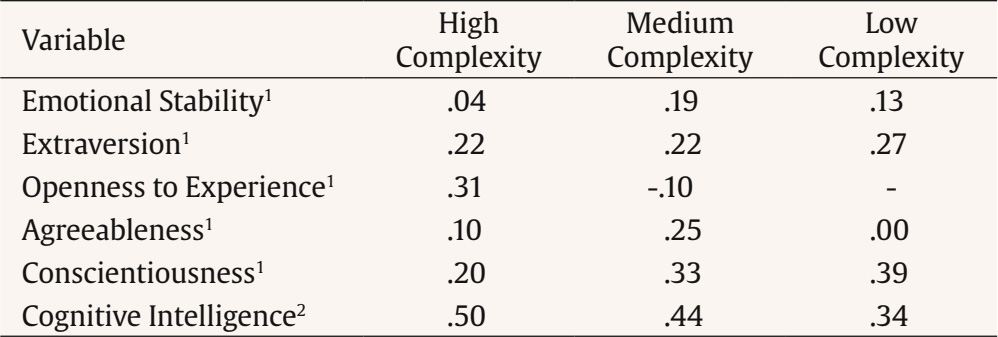 Note. 1Meta-analytic coefficients reported in Salgado (2017a); 2Meta-analytic coefficients reported in Salgado and Moscoso (2019). Table 6 Multiple Regression Analysis of the Big Five Personality Dimensions and Cognitive Intelligence  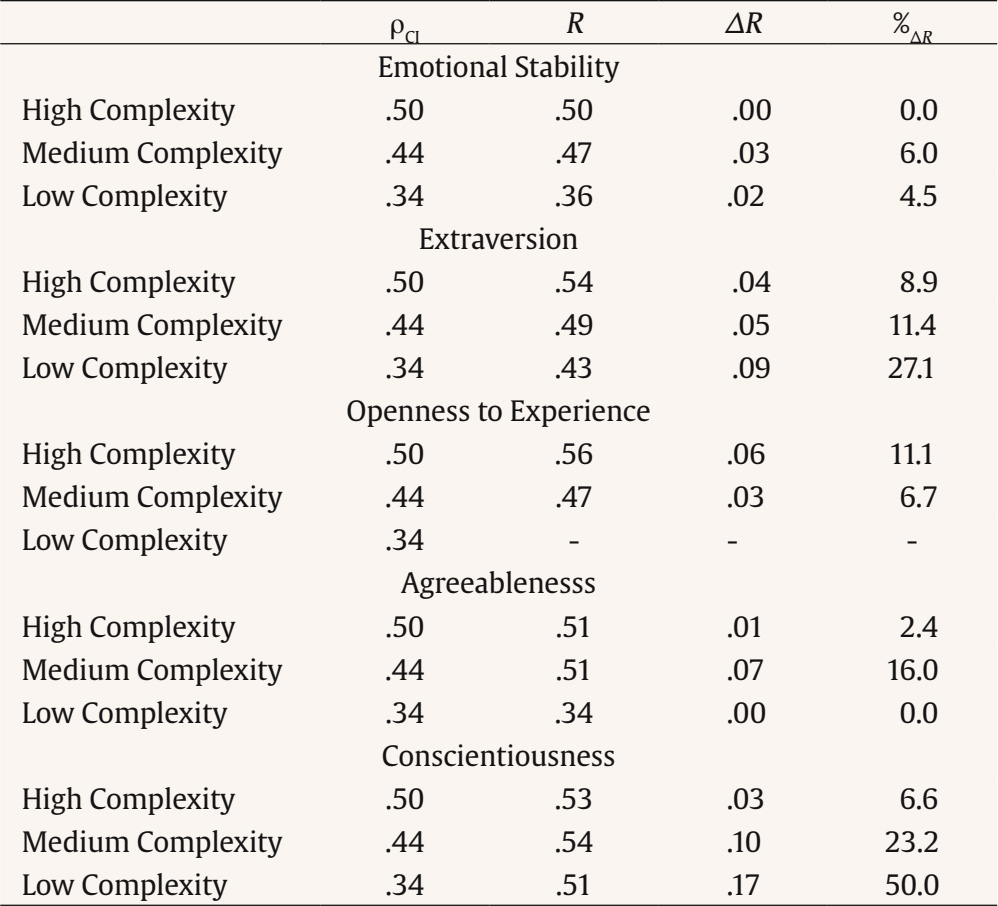 Note. Multiple regression analysis calculated with the reduced sample’ meta-analytics data (Table 1); ρCI = operational validity of CI; R = coefficient of multiple correlation; ΔR = increase in the multiple correlation; %ΔR = increase in the multiple correlation expressed in percentage. To estimate the degree of incremental validity of each of the Big Five personality dimensions, as assessed by QIFC over CI for predicting job performance, we conducted multiple regression analyses. To carry out these analyses, we used the operational validity coefficients of the Big Five for predicting job performance provided by Salgado (2017a) and the operational validity coefficients of CI for predicting job performance provided by Salgado and Moscoso (2019). These two meta-analyses estimated the predictive validity of CI, emotional stability, extraversion, openness to experience, agreeableness, and conscientiousness across the three levels of job complexity. Therefore, together with the meta-analytic estimates reported in Table 4, the validity estimates reported by Salgado (2017a) and Salgado and Moscoso (2019) are the correlation coefficients required for examining the incremental validity of the Big Five. Table 5 shows the operational validity estimates used for each variable across the job complexity levels for predicting job performance. Table 6 reports the results of the multiple regression analyses of the Big Five and CI across job complexity levels for predicting job performance. From left to right, we reported the operational validity of CI (ρCI; from Salgado & Moscoso, 2019), the coefficient of multiple correlation (R), the increase in the multiple correlation (ΔR), and the percentage of increase in the multiple correlation (%ΔR). As can be seen, the results indicate that the Big Five factors assessed with QIFC show incremental validity over CI for predicting job performance. However, the magnitude of the increment in the predictive validity varies depending on the personality factor and the level of job complexity. Specifically, in high complexity levels, the Big Five add less validity over CI for predicting job performance with the only exception being emotional stability. The other four personality factors show an increase in R ranging from .01 for agreeableness to .06 for openness to experience. Regarding medium-complexity jobs, all personality factors show incremental validity over CI, with the increase in R ranging from .03 for emotional stability and openness to experience to .10 for conscientiousness. Finally, personality adds more validity over CI for predicting job performance in low-complexity jobs, with R increases ranging from .02 for emotional stability to .17 for conscientiousness. This means an increase of up to 50% in R for the conscientiousness factor in low-complexity jobs (%ΔR = 50). Therefore, considering the results obtained as a whole, the findings support Hypothesis 2. The main goals of the present study were (a) to meta-analytically estimate the relationship between CI and the Big Five as assessed with QIFC inventories and (b) to examine the incremental validity of the Big Five assessed with QIFC over CI for predicting job performance across job complexity levels. Primary studies had examined the relationship between the Big Five assessed with QIFC and CI, but the findings revealed significant variability in the estimates of the QIFC and CI relationship, with some studies reporting negative correlations and others small to medium correlations (e.g., Bass, 1957; Christiansen et al., 2005; Converse et al., 2008; O'Neill et al., 2017; Otero et al., 2020; Salgado, 2016a. Therefore, the correlation between CI and QIFC was not well-known and, consequently, the question of whether QIFC shows incremental validity over CI for predicting job performance remained unanswered. Thus, the present research has made three unique contributions to the clarification of the relationship between CI and the Big Five as assessed with QIFC. The first unique contribution was to provide a robust estimate of the true correlation between CI and the Big Five, assessed with QIFC, this study being the first meta-analysis that has examined this relationship. Regarding this contribution, the results show small effects sizes between all the Big Five and CI, values ranging from -.02 to .18. Only openness to experience seems to share a small percentage of variance with CI, but this finding appears to be related to a specific QIFC, i.e., Drasgow et al.’s (2012) TAPAS. These results are consistent with those obtained by previous meta-analyses for the relationship between CI and the Big Five assessed with SS measures. Therefore, regardless of the type of personality measure used, FC or SS, the relationship between the Big Five and CI is very small. The second unique contribution was to examine the incremental validity of the Big Five over CI in predicting job performance when a QIFC inventory is used to assess personality dimensions. The results indicated, first, that personality shows incremental validity over CI and, second, that the magnitude of the incremental validity appears to be inversely proportional to the level of job complexity. That is, personality assessed with QIFC shows larger predictive validity for low complex jobs. This fact is particularly relevant in the case of conscientiousness. The findings show an incremental validity of conscientiousness over CI of 6.6% in high-complexity jobs, but it reaches 50% in low-complexity jobs. Finally, the third relevant contribution of this research has been to show that the personality dimensions assessed by QIFC have greater incremental validity over CI than SS for predicting job performance and that this validity varies depending on the level of job complexity. Implications for the Theory and Practice The results have relevant implications for both theory and professional practice. Regarding theoretical implications, the results reveal that there is a small relationship between the Big Five assessed with QIFC inventories and CI. Therefore, these findings indicate that personality and CI are independent constructs. In connection with this, the findings of this meta-analytic study imply that both are independent predictors of job performance. In relation to practical implications, given the multiple regression results that show the Big Five’s incremental validity over CI (especially conscientiousness in low-complexity jobs), the findings support the use of both variables as a combination of predictors of job performance in personnel selection contexts. In this sense, typically, combinations of two or more predictors are used in personnel selection (Schmidt & Hunter, 1998) and CI tests are often used as the main predictor. The findings support the use of QIFC inventories as supplementary predictors of job performance. Lastly, since previous studies have found that (1) QIFC inventories are useful tools to control faking (i.e., Cao & Drasgow, 2019; Martínez, 2020; Martínez et al., 2021), (2) they have higher predictive validity than SS inventories (Fisher et al., 2019; Salgado & Táuriz, 2014), and (3) the present findings support the idea that QIFC inventories are useful procedures for predicting job performance in combination with CI tests, we strongly recommend the use of these personality measures in personnel selection processes. Limitations of the Study and Future Research This research also has some limitations. First, in this study we have focused on QIFC inventories because this is the type of FC whose predictive validity has been most extensively studied (Fisher et al., 2019; Salgado et al., 2015; Salgado et al., 2014; Salgado, 2017a). In this regard, future research should expand on this meta-analysis to examine the correlation between the Big Five assessed across all formats of FC inventories and CI, thereby providing more precise conclusions about the relationship between the Big Five and CI. The second limitation of this study is that it was not possible to analyze other variables that could potentially moderate the relationship between QIFC and CI. For instance, the type of study design (whether in experimental contexts or in personnel selection processes) is an important factor that should also be analyzed to determine if it affects the results. Finally, it would be worthwhile to study whether the psychometric nature of QIFC can affect the relationship with CI. Many of the QIFC inventories included in this meta-analysis are based on Classical Test Theory (CTT). However, in recent years new QIFC inventories have been developed on the basis of the Thurstonian Item Response Theory (TIRT; Brown & Maydeu-Olivares, 2011, 2012, 2013; Fisher et al., 2019). Therefore, it would also be advisable to examine the relationship between the Big Five and CI according to the type of theoretical model on which the QIFC inventories are based (CTT vs. TIRT) in order to check whether the results obtained in this study remain stable. In summary, this study’s findings reveal zero-to-small correlations between CI and the Big Five, assessed with QIFC inventories. The correlations range from ρ = -.02 to ρ = .10, with the exception of openness to experience, which correlates .18 with CI. Moreover, the multiple regression analyses revealed that personality shows incremental validity over CI for predicting job performance. Conflict of Interest The authors of this article declare no conflict of interest. Author Contribution The authors listed have made a substantial, direct, and intellectual contribution to the work, and approved it for publication. Funding: The research reported in this article was partially supported by PID2020-116409GB-I00 to Jesús F. Salgado from the Spanish Ministry of Science and Innovation. Cite this article as: Martínez, A., Lado, M., Cuadrado, D., & Salgado, J. F. (2025). A meta-analysis of the relationship between cognitive intelligence and the big five assessed by quasiipsative forced-choice personality inventories: Implications for predicting job performance. Journal of Work and Organizational Psychology, 41(1), 19-26. https://doi.org/10.5093/jwop2025a3 References *References marked with an asterisk indicate studies included in the metaanalyses. |
Cite this article as: Martínez, A., Lado, M., Cuadrado, D., & Salgado, J. F. (2025). A Meta-analysis of the Relationship between Cognitive Intelligence and the Big Five Assessed by Quasi-Ipsative Forced-choice Personality Inventories: Implications for Predicting Job Performance. Journal of Work and Organizational Psychology, 41(1), 19 - 26. https://doi.org/10.5093/jwop2025a3
Correspondence: alexandra.martinez@usc.es (A. Martinez); jesus.salgado@usc.es (J. F. Salgado)., Correspondence: alexandra.martinez@usc.es (A. Martinez); jesus.salgado@usc.es (J. F. Salgado).Copyright © 2025. Colegio Oficial de la Psicología de Madrid


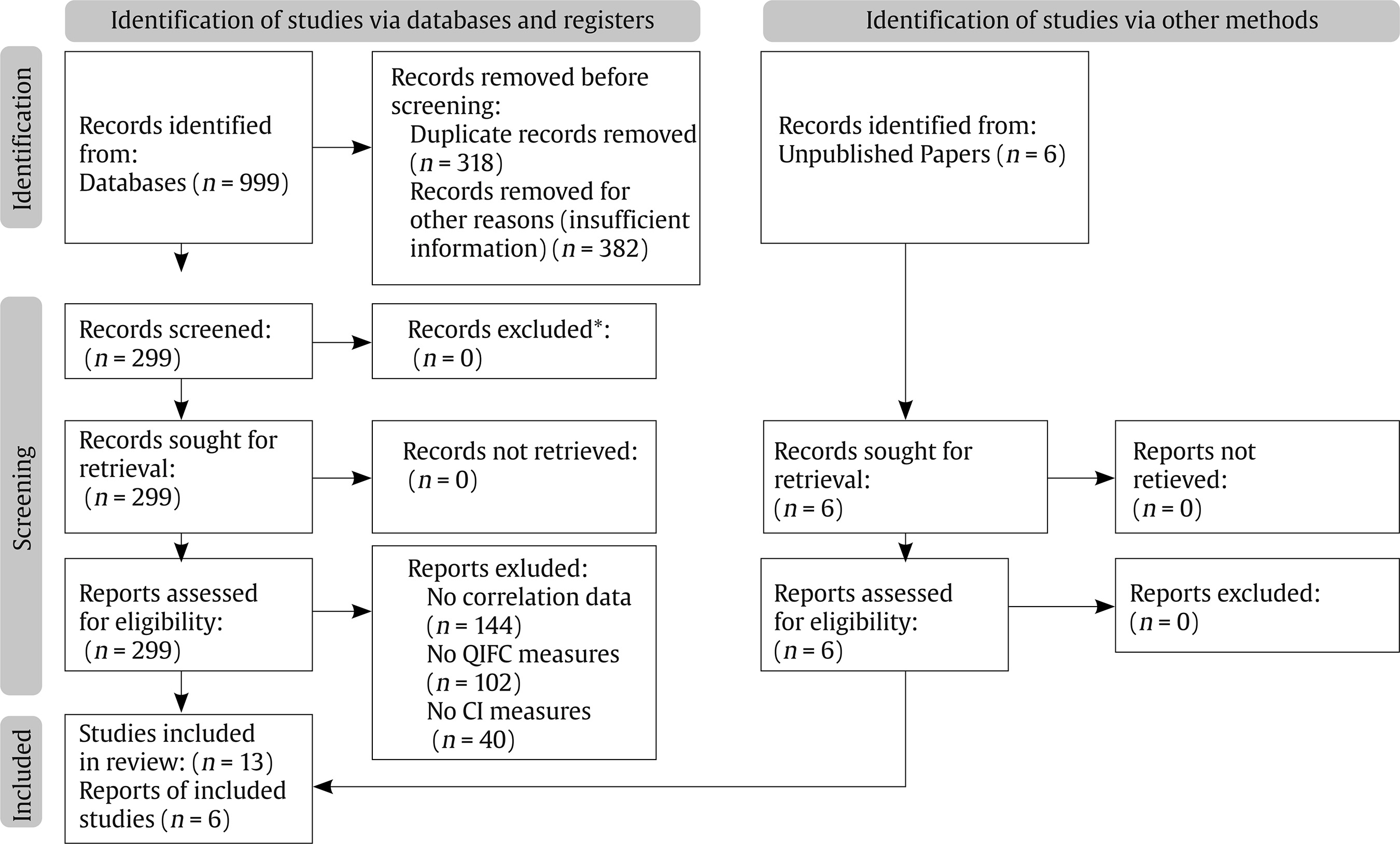

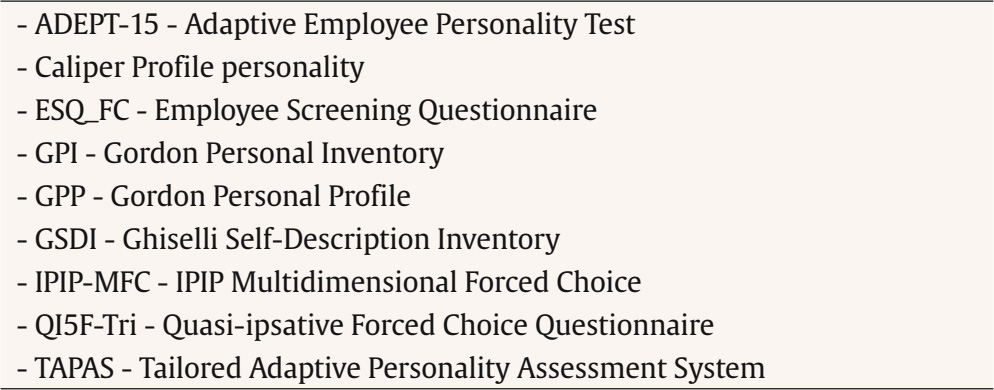






 e-PUB
e-PUB CrossRef
CrossRef JATS
JATS
